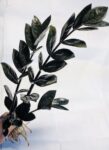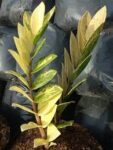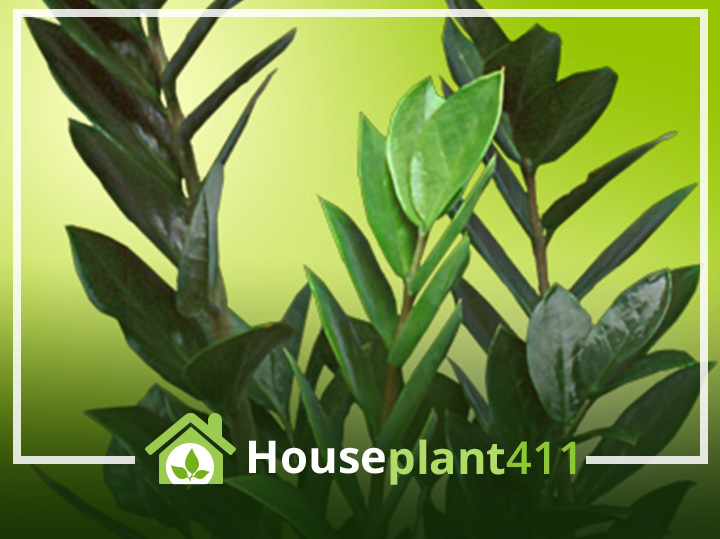ZZ Plant Description
A ZZ plant, Zamioculcas zamiifolia, has many names around the world: Eternity Plant, Emerald Palm, Zanzibar Gem, ZuZu Plant, and Aroid Palm. It was originally found growing as an outdoor, flowering plant in eastern Africa but can now be found growing in tropical areas around the world. It was a Dutch nursery in Africa that realized a ZZ plant would be a perfect houseplant and started to propagate and sell it world wide. A ZZ plant is a member of the Araceae family and a close relative of the dieffenbachia, anthurium, philodendron monstera, and caladium.
The unique looking, almost impossible to kill ZZ plant, is a slow growing, upright succulent plant that burst onto the houseplant market in the 1990’s. It became an immediate hit with indoor plant lovers because it grew almost anywhere and was tolerant of all types of care, except being over watered. What we call the the stems of a ZZ plant really the leaves of the plant. These long, thick “stems,” 15″-20″ tall ( ) are covered in hundreds of small, plump, shiny green, leathery leaflets (not leaves) that are about 2″-3″ long. During the summer and early fall the plant may produce small flowers hidden inside a 2″-3″ dark yellow or bronze colored spadex; flowering usually occurs when a ZZ plant is grown outdoors. The roots of the plant are fat rhizomes, underground horizontal stems, that store water and enable a ZZ plant to be drought resistant. In a lowlight, cool area, a ZZ plant can sometimes go three or four months without being watered; it simply uses the water that has been stored in the rhizomes to survive.ZZ Plant Varieties
ZZ Plant Varieties
ZZ plants are more expensive than common houseplants like a pothos or dieffenbachia because they are slow growers and it takes more time for them to grow large enough to be sold commercially. A variegated ZZ plant needs more light than the solid green variety. Direct sunlight can easily damage the leaves on all ZZ plants.
Regular ZZ plant has medium, dark green, shiny, plump leaves and tall thick stems with a swollen base.
“White Variegated” ZZ plant has green and white, shiny leaves and tall thick stems with a swollen base.
“Gold Variegated” ZZ plant has a mixture of leaves that can be solid green, solid yellow, or a green and yellow mix, and tall thick stems with a swollen base.
“Raven” ZZ plant has bright green leaves when first grown; but, as the plant matures, the leaves turn a very dark greenish black color.
“Lucky” ZZ plant is more compact with leaflets that are flatter and rounder.
Zenzi (“Dwarf Zenzi”) is a smaller, shorter, denser variety with the dark green leaflets growing closer together.



Raven White Variegated Gold Variegated
Quick Care Tips for a ZZ Plant
ZZ plant stores water in thick rhizomes so it very drought resistant. Over watering is the main reason a ZZ plant dies
Direct sun damages the leaves
Too much plant food causes yellow leaf burn
This is a very poisonous plant so wear gloves and long sleeves when propagating or pruning.
Conclusion
The ZZ plant may be one of the hardiest and most forgiving indoor plants I can recommend; just try not to kill it with kindness! Although a ZZ plant has also been shown by NASA to remove toxic pollutants such xylene and benzene from the air and is considered a “clean air” plant, it is also a very poisonous plant and extremely toxic to dogs, cats, and other pets. Small children are often attracted to the plump, bright green leaves, so keep your ZZ plant well out of reach. Read more about common houseplants that are poisonous in my book Don’t Feed Me to Your Cat: A Guide to Poisonous Houseplants.
Plant Care
Light
How much light does a ZZ plant need: These plants can survive in low light, but grow faster in bright, indirect light. Since a ZZ plant is a slow grower even in good light, in low light they rarely produces new leaves. Direct sun will fade and burn the leaves. Stems on a ZZ plant droop when there is not enough light and grow straight up when light is coming from above.
Water
How to water a ZZ plant: Over-watering is the main (and practically the only) way to kill a ZZ plant. This is a plant that stores water in its rhizomes and does do not like wet feet, so allow the soil to dry out before watering. Unlike most plants, a ZZ plant is very forgiving, allowing you to over-water a few times before showing signs of serious damage. Yellow leaves are an indication that the plant has been over-watered or severely under-watered. In very warm weather, a ZZ plant may need water every 7-10 days. In cooler weather, the soil may take 2-3 weeks to dry out. When you water, water well enough so the water comes out the drip holes in the bottom of the pot. Do not allow the plant to sit in the excess water.
Fertilizer
How to fertilize a ZZ plant: Feed monthly when the plant is actively producing new leaves and every other month when it is not in a growing phase. Use a balanced, liquid plant food diluted to 1/2 the recommended strength. Too much plant food causes yellow leaves due to “nutrient burn”.
Temperature
Best temperature for a ZZ plant: Temperatures between 60°-80°F (15.6°-26.7°C) are best. When the temperatures is below 60°F (16.6°C), the cold air slows down the plant growth.
Humidity
Humidity for a ZZ plant: ZZ plants grow well in basic household humidity.
Flowering
Does a ZZ plant flower: A ZZ plant can produce little white, spathe-type flowers similar to the ones you see on a Peace Lily, but this very rarely happens when the plant is grown indoors.
Pests
ZZ plant plant pests: A ZZ plant is very pest resistant.
Diseases
ZZ plant plant diseases: ZZ plants are also resistant to most plant plant diseases, but quite susceptible to root-rot due to over watering.
Soil
Soil for a ZZ plant: Use a well-aerated soil that retains water but still drains quickly. Add sand to the potting mixture if the soil becomes too heavy and compact.
Pot Size
Pot size for a ZZ plant: ZZ plants grow very slowly and need a new container about every two or three years. The new pot should be only one size larger and must have drip holes in the bottom. The best time to re-pot a ZZ plant is during the spring or early summer.
Pruning
How to prune a a ZZ plant: Prune yellow leaves and bare stems as soon as they develop.
Propagation
How to propagate a ZZ plant: The best best propagation method is to use stem or leaf cuttings. Be patient, it may take several months before you see any new growth on the cuttings. Read exactly how to propagate a plant using leaf and stem cuttings in the Glossary of the website.
Poisonous Plant Info
Is a ZZ plant poisonous: This is an extremely poisonous plant and very toxic to cats and dogs. Keep the plant out of the reach of small children who are tempted by the plump shiny leaves. A ZZ plant has a #4 toxicity level, the very highest level.
FAQ
The new growth on your ZZ plant may be turning brown and not opening because it is getting too much light, too much fertilizer, or too little humidity. The ends of the stems of your ZZ plant may be getting sunburned if the plant is in direct sunlight. Too much fertilizer causes salts to build up in the soil and this injures the ZZ plant leaves. If the air is extremely dry, ZZ plant leaves develop brown edges.
Yellow leaves are an indication that the plant has been over-watered or severely under-watered. water meters are not always reliable. If there is a lot of salt in the soil from too much plant food or if you are using water that has passed through a water softener (too salty) then a water meter is unreliable. In very warm weather, a ZZ plant may need water every 7-10 days. In cooler weather, the plant may be able to go 2-3 weeks before needing water. When you do water, water well enough so that the water comes out the drip holes in the bottom of the pot. Do not allow the plant to sit in the excess water in the saucer for more than 10 minutes. Yellow leaves can also be the result of nutrient burn. ZZ plants do not need much plant food. Feed monthly when actively grow and every other month the rest of the time. Always dilute your balanced, liquid plant food to 1/2 the recommended strength.
You should never fertilize a houseplant that is not actively growing. I think moving your ZZ plant to a brighter location might encourgae new growth. Do not rush to move it to a larger container. These plants produce more leaves when root-bound.

